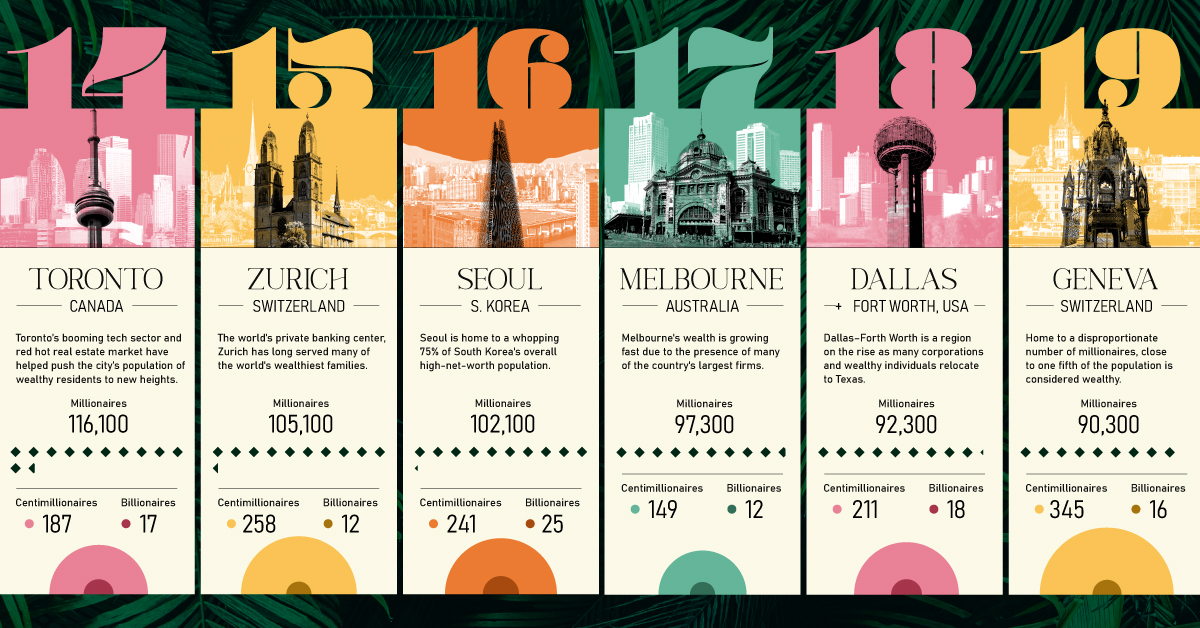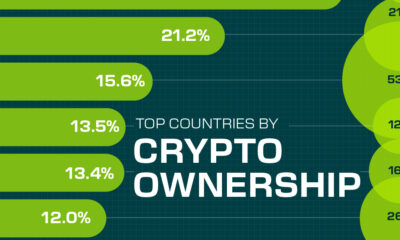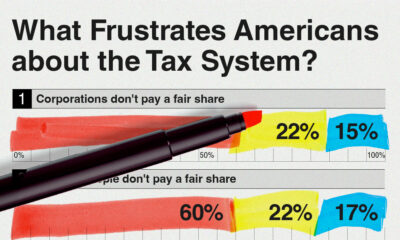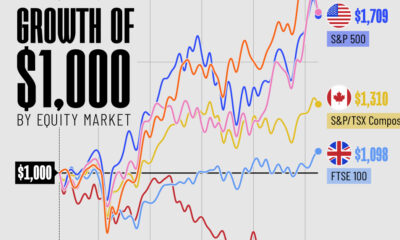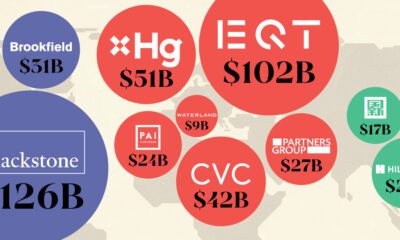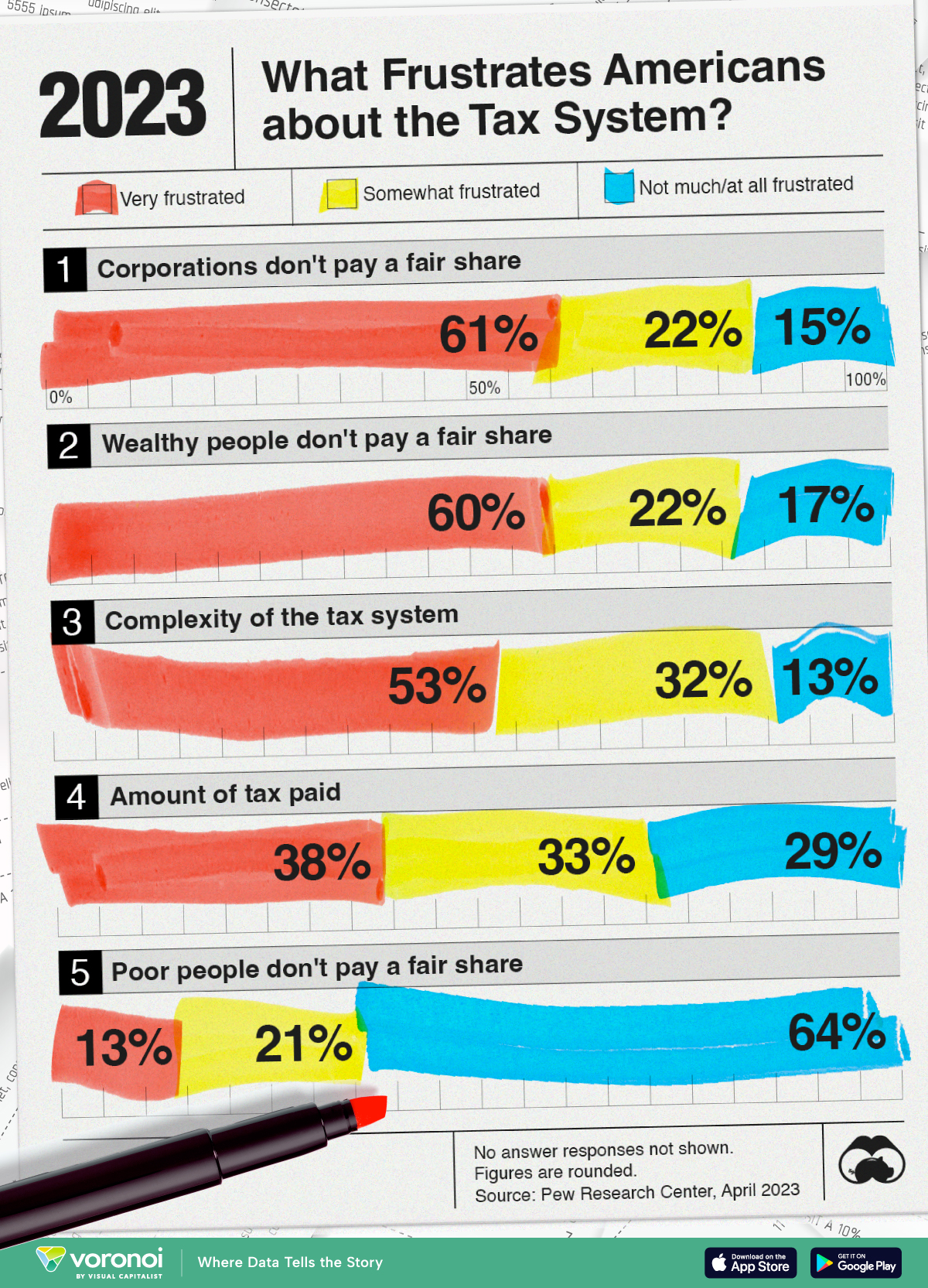Money
Ranked: The World’s Wealthiest Cities, by Number of Millionaires

The Top 20 Cities for the World’s Ultra-Wealthy
How many millionaires, centimillionaires, and billionaires live in the world’s wealthiest cities?
While such metrics are not all encompassing, these measurements of private wealth do help put the financial health and economic activity of some of the world’s wealthiest cities in perspective.
This infographic uses information from the Henley Global Citizens Report, in partnership with New World Wealth, to rank the world’s wealthiest cities. It leverages a comprehensive data set that tracks the movements and spending habits of high-net-worth individuals in over 150 cities around the world.
Which cities and regions have the biggest concentrations of millionaires around the world, each with a net worth greater than $1 million (USD)?
Millionaires and Billionaires in the Wealthiest Cities
In the latest edition of the ranking, North America has a strong showing with seven of the wealthiest cities, by number of millionaires.
In particular, the United States claims five of the cities in the top 10, including the very top spot with New York City.
| Rank | City | Country | Millionaires | Billionaires |
|---|---|---|---|---|
| #1 | New York | 🇺🇸 United States | 345,600 | 59 |
| #2 | Tokyo | 🇯🇵 Japan | 304,900 | 12 |
| #3 | San Francisco | 🇺🇸 United States | 276,400 | 62 |
| #4 | London | 🇬🇧 United Kingdom | 272,400 | 38 |
| #5 | Singapore | 🇸🇬 Singapore | 249,800 | 26 |
| #6 | Los Angeles | 🇺🇸 United States | 192,400 | 34 |
| #7 | Chicago | 🇺🇸 United States | 160,100 | 28 |
| #8 | Houston | 🇺🇸 United States | 132,600 | 25 |
| #9 | Beijing | 🇨🇳 China | 131,500 | 44 |
| #10 | Shanghai | 🇨🇳 China | 130,100 | 42 |
| #11 | Sydney | 🇦🇺 Australia | 129,500 | 16 |
| #12 | Hong Kong | 🇭🇰 China (SAR) | 125,100 | 28 |
| #13 | Frankfurt | 🇩🇪 Germany | 117,400 | 14 |
| #14 | Toronto | 🇨🇦 Canada | 116,100 | 17 |
| #15 | Zurich | 🇨🇭 Switzerland | 105,100 | 12 |
| #16 | Seoul | 🇰🇷 South Korea | 102,100 | 25 |
| #17 | Melbourne | 🇦🇺 Australia | 97,300 | 12 |
| #18 | Dallas | 🇺🇸 United States | 92,300 | 18 |
| #19 | Geneva | 🇨🇭 Switzerland | 90,300 | 16 |
| #20 | Paris | 🇫🇷 France | 88,600 | 15 |
| Top 20 Cities | 3,259,600 | 543 | ||
Asia is the region with the second most millionaires with six cities in the mix. Not surprisingly, China is home to three of these cities, including Hong Kong (SAR).
Europe comes in third with five cities, though only London makes into the top 10 portion of the ranking. Finally, Oceania has two cities on the list, both located in Australia.
How Top Cities Stack Up
Let’s take a closer look at some of the top-ranking cities making the list.
#1: New York
New York is the wealthiest city in the world—home to 345,600 millionaires with a total private wealth that exceeds $3 trillion.
New York is home to many Fortune 500 companies and is the financial heart of the United States, with the New York Stock Exchange and NASDAQ located in the Big Apple. Additionally, the city’s real estate market is known for being expensive, with sky-high property values and rents.
#2: Tokyo
Tokyo is the economic hub of Japan and is one of the most important cities in the world for business and finance. It is home to 304,900 resident millionaires, making it the city with the second most millionaires in the world.
Japan’s largest city is home to the Tokyo Stock Exchange, which is one of the largest stock exchanges in Asia by market capitalization. Tokyo is also a major center for banking and insurance, and is home to many multinational companies like Honda and Sony.
#3: San Francisco Bay Area
The San Francisco Bay Area boasts 276,400 millionaires. It’s known as the mecca of tech innovation, and as a result, the region has a high concentration of wealthy individuals. San Francisco also has the highest median household income in the country.
The number of millionaires has been growing steadily over the last 10 years, and if the trends of recent years hold, San Francisco could become the number one millionaire hub by 2040.
#4: London
London has been the world’s wealthiest city for years, but over the past decade there has been an outflow of millionaires.
Today, with 272,400 millionaires, the city holds a more humble position. London is known for its financial and business sectors, and it attracts a significant number of high-earning professionals who contribute to its reputation as a hub of wealth and luxury.
#5: Singapore
Singapore is home to 249,800 millionaires making it the second richest city in Asia after Tokyo.
Singapore has one of the highest densities of millionaire households in Asia, with over 5% of households having at least $1 million USD in net financial assets. This is due in part to the country’s strong economic growth and favorable business environment, which has attracted many wealthy individuals and families to the country. In addition, Singapore’s political stability, low crime rate, and high standard of living have also contributed to its appeal as a place to live and work.
Fastest Growing Cities for the Rich
The cities shown in our visualization are already well-established locations for high-net-worth individuals. Some of them have topped the rankings for decades, while some others are less well-known. But what are the fastest growing cities for the rich?
In 2022, cities with strong oil and gas industries like Riyadh, Sharjah, Dubai, Luanda, Abu Dhabi, Doha, and Lagos grew exceptionally. Cities in the UAE became millionaire magnets, attracting over 4,000 millionaires in 2022. In the U.S., a few tax-friendly states like Texas and Florida became home to American companies moving their head offices there.
Looking to the future, companies and high-net-worth individuals will inevitably move where they are treated best. Countries that want to attract wealthy individuals will have to apply tax-friendly policies along with other factors such as quality of life, safety, education, and access to amenities that ultra-wealthy residents value.
Wealth
Charted: What Frustrates Americans About the Tax System
A survey during peak tax filing season reveals two big complaints that Americans have with the federal tax system.
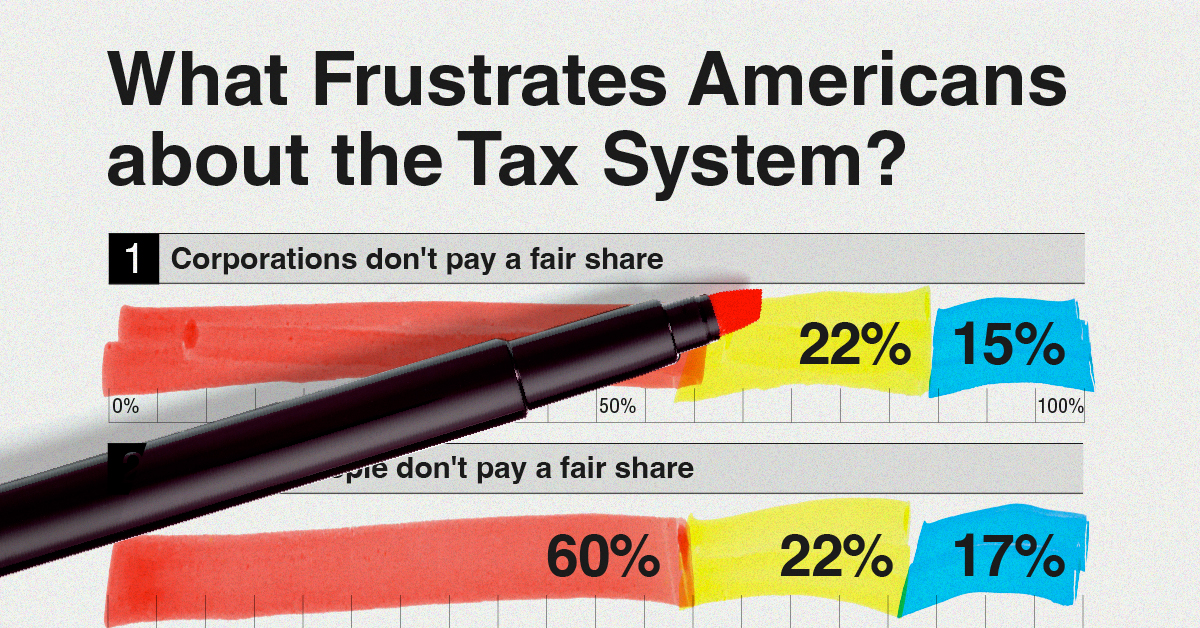
What Frustrates Americans About the Tax System
This was originally posted on our Voronoi app. Download the app for free on Apple or Android and discover incredible data-driven charts from a variety of trusted sources.
In this visualization, we show Pew Research’s findings on what bothers Americans the most about the tax system.
This data was collected after surveying more than 5,000 American adults between the period of March 27-April 2, 2023.
The survey was weighted to be representative of the U.S. adult population. Visit Pew Research’s methodology page for more details.
Americans Want More Taxes for Some
Six in every 10 Americans feel that both corporations and the wealthy don’t pay their fair share in federal taxes.
Their sentiments are not entirely unfounded.
| Very frustrated | Somewhat frustrated | Not much/ at all frustrated |
|
|---|---|---|---|
| 🏦 Corporations don't pay a fair share | 61% | 22% | 15% |
| 💼 Wealthy people don't pay a fair share | 60% | 22% | 17% |
| 🤔 Complexity of the tax system | 53% | 32% | 13% |
| 💸 Amount of tax paid | 38% | 33% | 29% |
| 🧑🤝🧑 Poor people don't pay a fair share | 13% | 21% | 64% |
Note: No answer responses are not shown, thus percentages may not sum to 100.
A 2021 ProPublica investigation found some of the wealthiest Americans—also the wealthiest people in the world—did not pay a single penny in federal income taxes in some years.
A significant part of why this is possible is how taxes are collected depending on the source. Since much of the top 1% grow their wealth in equity and property, they are not subject to taxes until they make an actual transaction.
As this Brookings Institution article explains: most Americans make money through their wages, and wages are subject to heavier taxation than capital income. Thus, the tax share of America’s highest-income households is often lower than America’s middle-income households.
Finally, Pew Research noted that their findings were essentially unchanged since 2021.
-
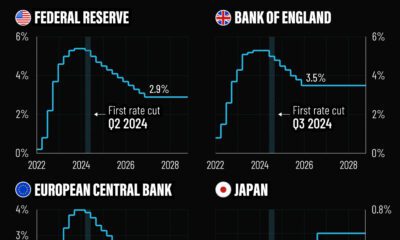
 Markets6 days ago
Markets6 days agoVisualized: Interest Rate Forecasts for Advanced Economies
-

 Markets2 weeks ago
Markets2 weeks agoEconomic Growth Forecasts for G7 and BRICS Countries in 2024
-

 Wealth2 weeks ago
Wealth2 weeks agoCharted: Which City Has the Most Billionaires in 2024?
-

 Technology2 weeks ago
Technology2 weeks agoAll of the Grants Given by the U.S. CHIPS Act
-

 Green2 weeks ago
Green2 weeks agoThe Carbon Footprint of Major Travel Methods
-

 United States1 week ago
United States1 week agoVisualizing the Most Common Pets in the U.S.
-

 Culture1 week ago
Culture1 week agoThe World’s Top Media Franchises by All-Time Revenue
-
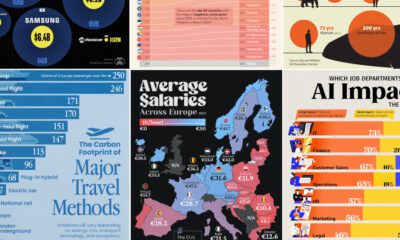
 voronoi1 week ago
voronoi1 week agoBest Visualizations of April on the Voronoi App




